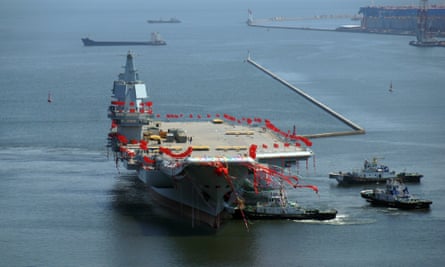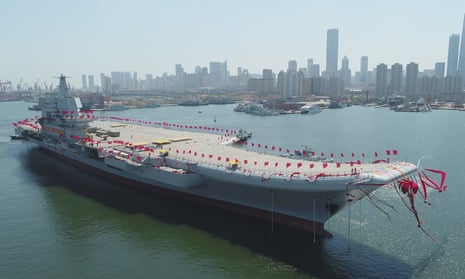China has launched its first domestically built aircraft carrier, which will join an existing one bought secondhand from Ukraine, amid rising tensions over North Korea and worries about Beijing’s assertiveness in the South China Sea.
The 50,000-ton carrier was towed from its dockyard just after 9 am on Wednesday after a ceremony in the northern port city of Dalian, where its predecessor, the Soviet-built Liaoning, also underwent extensive refurbishing before being commissioned in 2012, the Ministry of National Defence said.
Development of the new carrier began in 2013 and construction in late 2015. It is expected to be formally commissioned before 2020, after sea trials and the arrival of its full air complement.
Like the 60,000-ton Liaoning, the new carrier is based on the Soviet Kuznetsov class design, with a ski jump-style deck for taking off and a conventional oil-fuelled steam turbine power plant. That limits the weight of payloads its planes can carry, its speed and the amount of time it can spend at sea relative to American nuclear-powered carriers.
The main hull of the new carrier has been completed and its power supply put into place. Next up are mooring tests and the debugging of its electronic systems, the ministry said.

China is believed to be planning to build at least two and possibly up to four additional carriers, with one of them, the Type 002, reported to be under construction at a shipyard outside Shanghai. They are expected to be closer in size to the US navy’s nuclear-powered 100,000-ton Nimitz-class ships, with flat flight decks and catapults to allow planes to launch with more bombs and fuel aboard.
Along with their role in protecting China’s maritime interests, Chinese naval strategists see the carrier programme as being “about having naval power commensurate with China’s international status, to impress both external and domestic audiences,” said Michael Chase, an expert on the Chinese military at US thinktank the Rand Corporation.
“[The new carrier] is likely to be seen as further evidence of China’s desire to become the most powerful and influential country in the region,” Chase said. That would be especially worrying to Indian security analysts who were already concerned about Beijing’s ambitions in the Indian Ocean, he said.
India, along with Japan and Taiwan, which also viewed Chinese carriers as threats, would probably respond by building additional submarines and anti-ship missiles, said Ian Easton, a research fellow at the Project 2049 Institute in Arlington, Virginia.

“[China’s] expansionist behaviour in the South China Sea and its aggressive efforts to undermine the security of Taiwan and Japan, in particular, have translated into a situation where few countries now trust that Beijing has benign motives,” he said.
China claims Taiwan as its territory to be brought under control by force if necessary, and was seen as displaying that threat when it sailed the Liaoning through the Taiwan Strait earlier this year.
The new carrier is part of an ambitious expansion of the Chinese navy, which is projected to have between 265 and 273 warships, submarines and logistics vessels by 2020, according to the Washington DC-based Center for Naval Analyses. That compares with 275 deployable battle force ships presently in the US navy, China’s primary rival in the Asia Pacific.
The US operates 10 aircraft carriers, has 62 destroyers to China’s 32, and 75 submarines to China’s 68. The US navy has 323,000 personnel to China’s 235,000.
China has offered little information about the roles it expects its carriers to play, although its planning appears to be evolving as it gains more experience.
The Liaoning was initially touted mainly as an experimental and training platform, but in December was declared to be combat-ready and has taken part in live-firing exercises in the South China Sea, where tensions have risen over China’s construction of manmade islands complete with airstrips and military structures.

Comments (…)
Sign in or create your Guardian account to join the discussion